Fire and rebuilding
In 1912, a fire destroyed the interior of the church. Rebuilding the facilities took some time. The 50th anniversary of St Paul's was in 1916 but was not celebrated until 1918.
In 1925, The Presbyterian Church in Canada voted to merge with the Methodist Church of Canada and the Congregationalist Union to form the United Church of Canada. St. Paul's congregation, and about 30% of other Presbyterian congregations in Canada, voted not to participate in the merger and remained independent of the newly formed church. The terms Continuing Presbyterians and Non-Concurring Presbyterians were then used by those who did not participate in the merger. St. Paul's and those other congregations regained the legal right to use the name "Presbyterian Church in Canada" in 1939 when the Supreme Court of Canada found that the United Church, while initially holding the rights as the successor to the original Presbyterian Church in Canada, had effectively vacated the name through non use, and it was available to the non-concurring Presbyterians.
In 1950, a new hall was completed at St. Paul's and the Alexander MacDonald Memorial Hall was established in Caledonia. The pipe organ was rebuilt in 1964.
The 100th Anniversary was celebrated in 1966 with special services on September 27, October 2 with a Gaelic language service, October 9, and October 16 with a Chinese language service. As a special project of the congregation for the 100th Anniversary, new stained glass windows were installed in the sanctuary. The windows were designed by Gerald E. Mesterom and built by Montreal Stained Glass and Art Works of Pointe-Claire, Quebec. They were dedicated by the Moderator of the General Assembly, Rev. Dr. G. Deane Johnston of Brantford, Ontario.
In 1970, St. Paul's entered a float in the Glace Bay Centennial Parade which won first prize in the historical category.
On November 6, 1983, the War Veterans Memorial Plaque was dedicated. Nova Scotia Premier John Buchanan was a special guest for the event.
New beginnings
In 1984 the future of the then current church building began to be discussed. Concerns about structural integrity, repair costs, and functionality were raised as the congregation struggled with the choice of trying to correct the problems in the existing structure or move to a new building. In 1991 a decision was made to construct a new church on Brookside Street in Glace Bay and in July architects Gavel and Associates began designing the new facility. In 1993, the sod was turned on the new construction site.
Due to construction problems and financial issues, costs on the new church went far over expectations and the congregation faced a potentially crippling debt. Through sacrifices by the congregation and assistance from other Presbyterian churches, the debt was reduced from 1.1 million dollars to something just over $200,000 between 1995 and 2000. [1] On March 23, 2005, the final payment was made on the loan. St. Paul's paid $600,000 towards the loan, and the Presbyterian Church raised $569,172. The joyous event, commemorated by a thanksgiving service in May, marked the end of what had once been a crushing debt that existed since 1993. [2]
At present, the congregation meets at the church on Brookside Street and the old St Paul's site on Commercial Street was demolished and turned into a park.

The Free Presbyterian Church of Scotland was formed in 1893. The Church identifies itself as the spiritual descendant of the Scottish Reformation. The Church web-site states that it is 'the constitutional heir of the historic Church of Scotland'. Its adherents are occasionally referred to as Seceders or the Wee Wee Frees. Although small, the church has congregations on five continents.
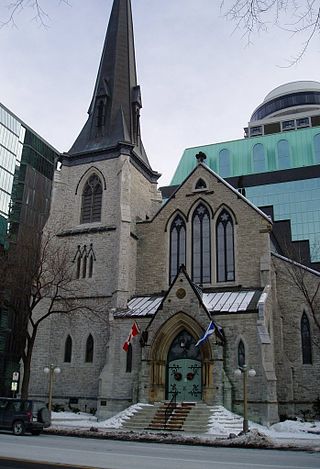
St. Andrew's Presbyterian Church is the oldest Presbyterian church in Ottawa, Ontario, Canada.

James Nisbet was a Scottish born missionary to Canada.

The Presbyterian Church in Canada is a Presbyterian denomination, serving in Canada under this name since 1875. The United Church of Canada claimed the right to the name from 1925 to 1939. According to the Canada 2001 Census 409,830 Canadians identify themselves as Presbyterian, that is, 1.4 percent of the population.

St. Giles Presbyterian Church is a member of the Presbyterian Church in Canada located in Ottawa, Ontario, Canada. It was formed in 1925 by a minority group from Glebe Presbyterian, and a few other congregations, that did not support the vote to enter the United Church of Canada.
Walter George Brown was a Presbyterian Church in Canada minister who opposed the formation of the United Church of Canada and was a United Reform Movement MP in the House of Commons of Canada.

St. Andrew's Church is a historic Presbyterian church located at the corner of King Street West and Simcoe Street in the city's downtown core of Toronto, Ontario, Canada. It was designed by William George Storm in the Romanesque Revival style and completed in 1876.
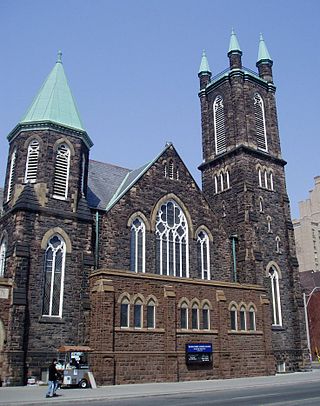
Bloor Street United Church is a United Church of Canada church in Toronto, Ontario, Canada. It is located on Bloor Street West in the downtown core near the intersection with Huron Street. It is just north of the University of Toronto, and between the Spadina and St. George subway stations.

Knox Presbyterian Church is a Presbyterian church in downtown Toronto, Ontario, Canada.
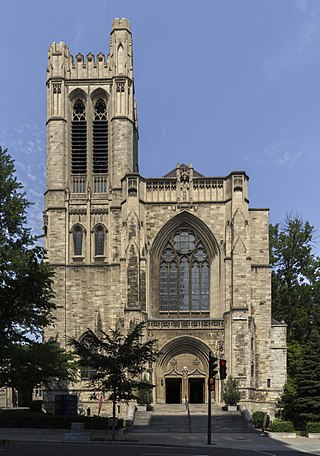
The Church of Saint Andrew and St Paul is a Presbyterian church in downtown Montreal, Quebec, Canada. It is located at 3415 Redpath Street, on the corner of Sherbrooke Street. It is in close proximity to the Golden Square Mile, the Montreal Museum of Fine Arts, Concordia University as well as the Guy-Concordia Metro station.
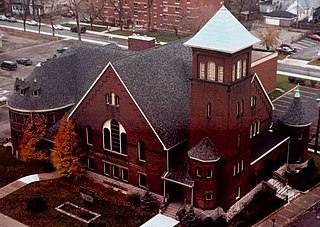
St. Andrew's Presbyterian Church, is a Presbyterian Church in Canada congregation in downtown Windsor, Ontario, Canada. The congregation dates back to 1857, and at one time, was the largest congregation by membership within the Presbyterian Church in Canada (PCC).
The Free Church of Scotland is an evangelical, Calvinist denomination in Scotland. It is the continuation the original Free Church of Scotland that remained outside the union with the United Presbyterian Church of Scotland in 1900, and remains a distinct Presbyterian denomination in Scotland.

St Columba's Church is one of the two London congregations of the Church of Scotland. The church building, designed by Sir Edward Maufe, is located in Pont Street, Knightsbridge, near Harrod's department store. It was given Grade II listing by English Heritage in 1988.

St Columba's Church is a Church of Scotland Parish church that used to serve a Gaelic congregation in Glasgow until its closure in 2021.
The Rev William Miller (1815–1874) was a Scots-born minister of the Free Presbyterian Church of Victoria who served the John Knox Church, cnr Little Lonsdale and Swanston streets, Melbourne 1851–64, and was the first Chairman of the council of Scotch College, Melbourne.
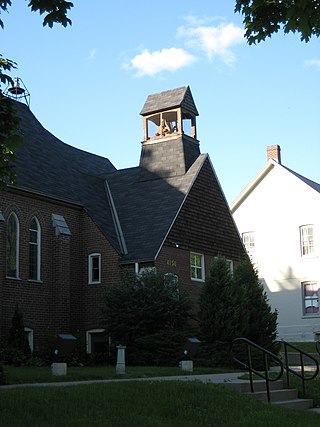
Knox Presbyterian Church is located at 4156 Sheppard Avenue East in the Agincourt neighbourhood of Toronto, Ontario, Canada.

St Stephen's Uniting Church is a congregation of the Uniting Church located at 197 Macquarie Street, in the Sydney central business district, in the City of Sydney local government area of New South Wales, Australia. It is part of the Sydney Presbytery and the NSW-ACT Synod.

Hugh McLeod was a Scottish-born Presbyterian minister who was a founder of the Scottish Free Church in Canada.
Robert James Drummond (1858–1951) was a Scottish minister who served as Moderator of the General Assembly of the United Free Church of Scotland in 1918. He served as Chaplain to the King in Scotland.

The Highland Church was a Gaelic-speaking congregation of the Church of Scotland, based in Tollcross, Edinburgh. Formed by the union of St Oran's Church and St Columba's Gaelic Church in 1948, the congregation continued united with Tolbooth St John's in 1956.
















